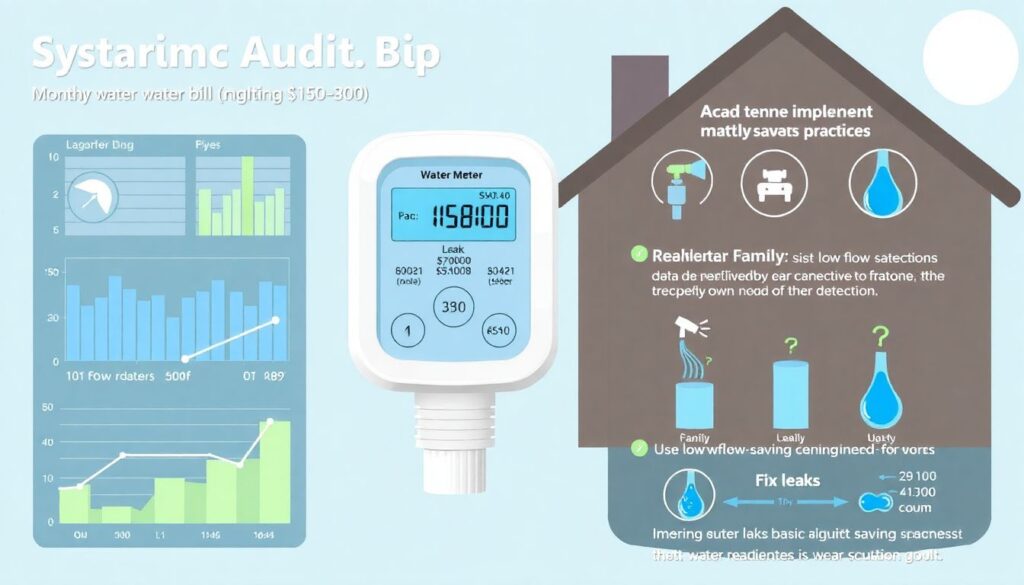Understanding Water Efficiency and Green Living
Definition of Key Concepts
In the context of sustainable lifestyles, *water efficiency* refers to the strategy of using the minimum amount of water necessary for daily activities without compromising functionality or hygiene. This contrasts with mere water conservation, which often implies restricting usage. *Green living*, on the other hand, is a broader philosophy that integrates ecological responsibility into every aspect of life—energy consumption, waste management, transportation, and resource utilization, with water being a critical component. As of early 2025, water efficiency is no longer a niche concept but a necessary adaptation in many regions due to increasing droughts and climate pressures.
Visualizing Domestic Water Use
Domestic water use can be visualized as a pie chart where major categories include toilets (25–30%), showers (20–25%), faucets (15–20%), washing machines (15–20%), and leaks (approximately 10%). Understanding this breakdown is crucial for targeting cost-effective changes. For instance, despite widespread assumptions, reducing toilet flush volume often yields more savings than limiting handwashing.
Low-Cost Technologies for Reducing Water Usage
Retrofit Devices and Fixtures
One cost-effective strategy is retrofitting existing plumbing with water-efficient devices. Faucet aerators, for example, reduce flow rates from 2.2 gallons per minute (GPM) to 1.0 GPM without perceptible loss in convenience. Compared to upgrading entire plumbing systems, installing aerators or low-flow showerheads incurs a minimal upfront cost—often under $10 per unit—and leads to a 40–60% reduction in fixture-specific usage. These technologies are passive, requiring no behavioral change, and thus appeal to users seeking set-it-and-forget-it solutions.
Behavioral Alternatives Versus Technical Solutions
Some advocate for behavioral changes instead of technological interventions—shorter showers, turning off taps while brushing teeth, or recycling greywater for garden use. While these changes are valuable, studies show that their consistency varies greatly across households. In contrast, technical interventions such as dual-flush toilets guarantee water savings regardless of user habits. The best results emerge from combining both approaches for cumulative effect.
Reusing Water: Greywater Systems on a Budget
Basics of Greywater Reuse
*Greywater* refers to gently used water from showers, sinks, and laundry machines that can be reused for non-potable purposes like irrigation or toilet flushing. While full-scale greywater systems can cost thousands of dollars, budget-conscious homeowners can implement simpler versions. For example, a gravity-fed hose redirecting water from a washing machine to a backyard garden costs less than $100 and provides direct benefits during the dry season. The potential annual water savings from a basic greywater setup can exceed 10,000 gallons, particularly in households with frequent laundry.
Comparison to Rainwater Harvesting
Rainwater harvesting is often promoted as a sustainable alternative, but it presents limitations in arid or highly seasonal climates. Greywater, on the other hand, is available year-round and aligns directly with indoor water use. The reliability and immediacy of greywater make it a better candidate for direct reuse, especially when water utility prices are high. Nevertheless, combining both systems can create a resilient water management system that maximizes sustainability.
Utility Bill Analysis and Forecasting Savings
Evaluating Financial Impact

A systematic audit of monthly water bills provides a foundational insight into consumption trends. Installing a smart water meter, costing between $150–300, can enable real-time leak detection and trend mapping. In past cases, families who adopted basic water-saving practices and technologies reported bill reductions of up to 35%. For a household spending $1200 annually on water, this translates to savings of $400—quickly offsetting technology costs.
Predictive Modeling of Long-Term Benefits
By 2025, the integration of AI-driven water analytics in smart homes is increasingly common. These systems can forecast seasonal water demand, suggest optimal irrigation schedules, and auto-detect wastage. As utility providers implement tiered pricing models—charging higher rates after a certain usage threshold—households employing predictive tools can proactively manage consumption and avoid financial penalties.
Community-Level Approaches and Cooperative Savings
Collective Water Management Models
While individual efforts matter, community-level water-saving cooperatives yield larger systemic benefits. Shared greywater treatment units in apartment complexes or coordinated irrigation timing in residential zones are emerging in urban planning models. In cities like Melbourne and Cape Town, such community initiatives have reduced per-capita water use by over 40%. For budget-conscious citizens, this translates to both individual and shared infrastructure savings.
Public Policy and Incentives
Governments and local water boards increasingly offer rebates and incentives for installing water-efficient equipment. In 2025, programs in regions like California and Western Australia cover up to 70% of installation costs for rain barrels and drip irrigation systems. Awareness of these programs is essential for maximizing return on investment in residential water-saving initiatives. Thus, the intersection of public policy and private initiative forms a critical lever for sustainable impact.
Future Outlook: Water Resilience in a Changing Climate
Technological Evolution and Market Trends

Looking toward 2030, the water-saving market is expected to grow by 18% annually, driven by innovation in sensors, AI, and eco-design plumbing. Startups are developing water purification membranes that operate with near-zero energy input, while larger manufacturers are integrating blockchain-based water credit systems to reward reduced consumption. The convergence of digital infrastructure with resource efficiency heralds a new paradigm of water-smart homes, particularly in drought-prone regions.
Climate Pressure and Adaptive Strategies
Policy frameworks in 2025 increasingly recognize water stress as a core issue of climate resilience. Urban centers are integrating water-saving metrics into building codes and development permits. Meanwhile, adaptive landscaping—choosing native, drought-tolerant plants—is becoming standard practice. As these measures evolve, water use efficiency will no longer be seen as optional but as an embedded requirement in the urban lifestyle of the next decade.
In sum, water-saving on a budget is not only feasible but increasingly essential. A blend of accessible technologies, data analysis, and behavioral adaptation offers both immediate financial relief and long-term ecological benefits. As we progress through the 2020s, integrating water resilience into everyday life will be a defining feature of truly sustainable living.

